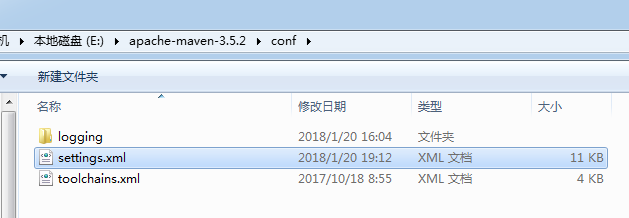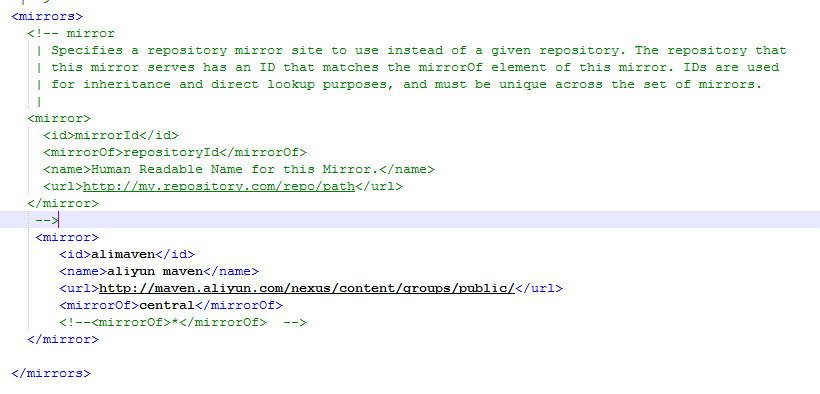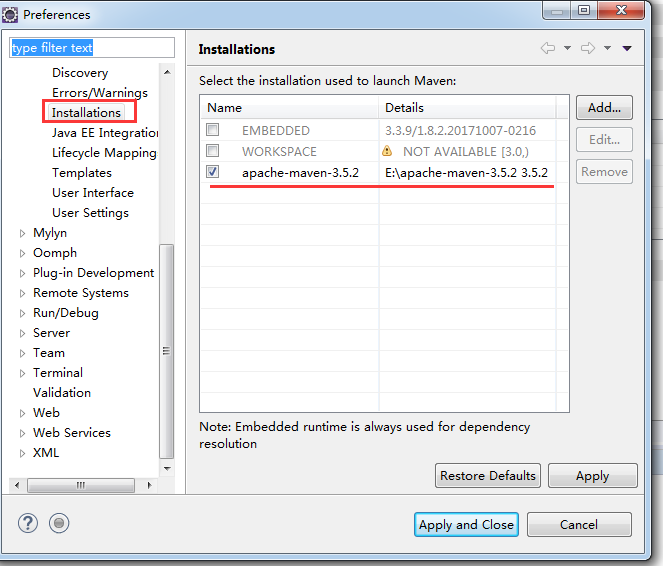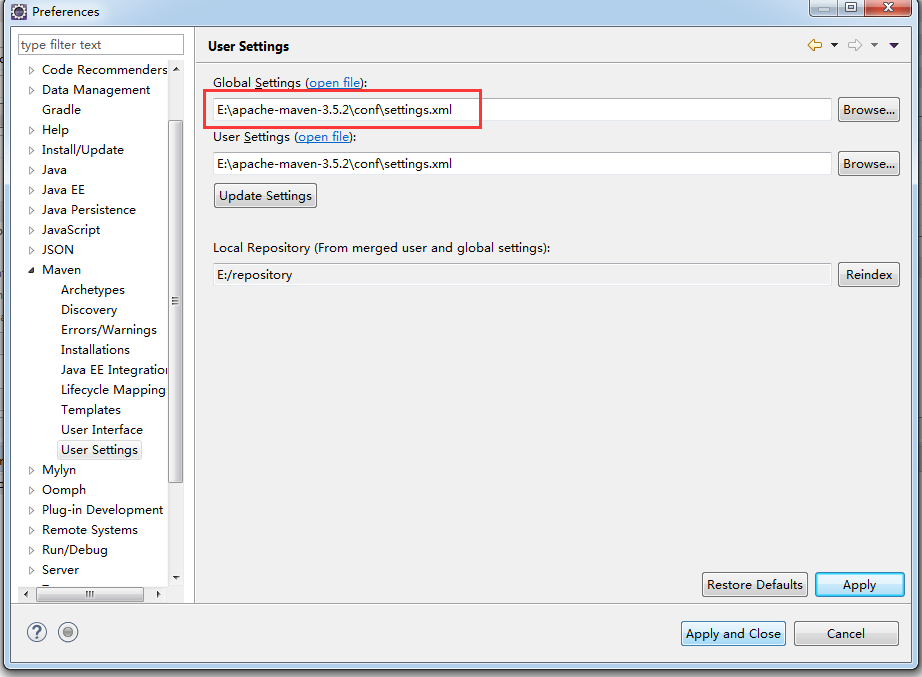简单整理一下,方便理解操作。
1、本地拷贝maven文件后,打开maven中的.setting 文件:

2、配置文件:

1 <?xml version="1.0" encoding="UTF-8"?> 2 3 <!-- 4 Licensed to the Apache Software Foundation (ASF) under one 5 or more contributor license agreements. See the NOTICE file 6 distributed with this work for additional information 7 regarding copyright ownership. The ASF licenses this file 8 to you under the Apache License, Version 2.0 (the 9 "License"); you may not use this file except in compliance 10 with the License. You may obtain a copy of the License at 11 12 http://www.apache.org/licenses/LICENSE-2.0 13 14 Unless required by applicable law or agreed to in writing, 15 software distributed under the License is distributed on an 16 "AS IS" BASIS, WITHOUT WARRANTIES OR CONDITIONS OF ANY 17 KIND, either express or implied. See the License for the 18 specific language governing permissions and limitations 19 under the License. 20 --> 21 22 <!-- 23 | This is the configuration file for Maven. It can be specified at two levels: 24 | 25 | 1. User Level. This settings.xml file provides configuration for a single user, 26 | and is normally provided in ${user.home}/.m2/settings.xml. 27 | 28 | NOTE: This location can be overridden with the CLI option: 29 | 30 | -s /path/to/user/settings.xml 31 | 32 | 2. Global Level. This settings.xml file provides configuration for all Maven 33 | users on a machine (assuming they're all using the same Maven 34 | installation). It's normally provided in 35 | ${maven.conf}/settings.xml. 36 | 37 | NOTE: This location can be overridden with the CLI option: 38 | 39 | -gs /path/to/global/settings.xml 40 | 41 | The sections in this sample file are intended to give you a running start at 42 | getting the most out of your Maven installation. Where appropriate, the default 43 | values (values used when the setting is not specified) are provided. 44 | 45 |--> 46 <settings xmlns="http://maven.apache.org/SETTINGS/1.0.0" 47 xmlns:xsi="http://www.w3.org/2001/XMLSchema-instance" 48 xsi:schemaLocation="http://maven.apache.org/SETTINGS/1.0.0 http://maven.apache.org/xsd/settings-1.0.0.xsd"> 49 <!-- localRepository 50 | The path to the local repository maven will use to store artifacts. 51 | 52 | Default: ${user.home}/.m2/repository --> 53 <localRepository>E:/repository</localRepository> 54 55 56 <!-- interactiveMode 57 | This will determine whether maven prompts you when it needs input. If set to false, 58 | maven will use a sensible default value, perhaps based on some other setting, for 59 | the parameter in question. 60 | 61 | Default: true 62 <interactiveMode>true</interactiveMode> 63 --> 64 65 <!-- offline 66 | Determines whether maven should attempt to connect to the network when executing a build. 67 | This will have an effect on artifact downloads, artifact deployment, and others. 68 | 69 | Default: false 70 <offline>false</offline> 71 --> 72 73 <!-- pluginGroups 74 | This is a list of additional group identifiers that will be searched when resolving plugins by their prefix, i.e. 75 | when invoking a command line like "mvn prefix:goal". Maven will automatically add the group identifiers 76 | "org.apache.maven.plugins" and "org.codehaus.mojo" if these are not already contained in the list. 77 |--> 78 <pluginGroups> 79 <!-- pluginGroup 80 | Specifies a further group identifier to use for plugin lookup. 81 <pluginGroup>com.your.plugins</pluginGroup> 82 --> 83 </pluginGroups> 84 85 <!-- proxies 86 | This is a list of proxies which can be used on this machine to connect to the network. 87 | Unless otherwise specified (by system property or command-line switch), the first proxy 88 | specification in this list marked as active will be used. 89 |--> 90 <proxies> 91 <!-- proxy 92 | Specification for one proxy, to be used in connecting to the network. 93 | 94 <proxy> 95 <id>optional</id> 96 <active>true</active> 97 <protocol>http</protocol> 98 <username>proxyuser</username> 99 <password>proxypass</password> 100 <host>proxy.host.net</host> 101 <port>80</port> 102 <nonProxyHosts>local.net|some.host.com</nonProxyHosts> 103 </proxy> 104 --> 105 </proxies> 106 107 <!-- servers 108 | This is a list of authentication profiles, keyed by the server-id used within the system. 109 | Authentication profiles can be used whenever maven must make a connection to a remote server. 110 |--> 111 <servers> 112 <!-- server 113 | Specifies the authentication information to use when connecting to a particular server, identified by 114 | a unique name within the system (referred to by the 'id' attribute below). 115 | 116 | NOTE: You should either specify username/password OR privateKey/passphrase, since these pairings are 117 | used together. 118 | 119 <server> 120 <id>deploymentRepo</id> 121 <username>repouser</username> 122 <password>repopwd</password> 123 </server> 124 --> 125 126 <!-- Another sample, using keys to authenticate. 127 <server> 128 <id>siteServer</id> 129 <privateKey>/path/to/private/key</privateKey> 130 <passphrase>optional; leave empty if not used.</passphrase> 131 </server> 132 --> 133 </servers> 134 135 <!-- mirrors 136 | This is a list of mirrors to be used in downloading artifacts from remote repositories. 137 | 138 | It works like this: a POM may declare a repository to use in resolving certain artifacts. 139 | However, this repository may have problems with heavy traffic at times, so people have mirrored 140 | it to several places. 141 | 142 | That repository definition will have a unique id, so we can create a mirror reference for that 143 | repository, to be used as an alternate download site. The mirror site will be the preferred 144 | server for that repository. 145 |--> 146 <mirrors> 147 <!-- mirror 148 | Specifies a repository mirror site to use instead of a given repository. The repository that 149 | this mirror serves has an ID that matches the mirrorOf element of this mirror. IDs are used 150 | for inheritance and direct lookup purposes, and must be unique across the set of mirrors. 151 | 152 <mirror> 153 <id>mirrorId</id> 154 <mirrorOf>repositoryId</mirrorOf> 155 <name>Human Readable Name for this Mirror.</name> 156 <url>http://my.repository.com/repo/path</url> 157 </mirror> 158 --> 159 <!--<mirror> 160 <id>alimaven</id> 161 <name>aliyun maven</name> 162 <url>http://maven.aliyun.com/nexus/content/groups/public/</url> 163 //<mirrorOf>central</mirrorOf> 164 <mirrorOf>*</mirrorOf> 165 </mirror>--> 166 167 </mirrors> 168 169 <!-- profiles 170 | This is a list of profiles which can be activated in a variety of ways, and which can modify 171 | the build process. Profiles provided in the settings.xml are intended to provide local machine- 172 | specific paths and repository locations which allow the build to work in the local environment. 173 | 174 | For example, if you have an integration testing plugin - like cactus - that needs to know where 175 | your Tomcat instance is installed, you can provide a variable here such that the variable is 176 | dereferenced during the build process to configure the cactus plugin. 177 | 178 | As noted above, profiles can be activated in a variety of ways. One way - the activeProfiles 179 | section of this document (settings.xml) - will be discussed later. Another way essentially 180 | relies on the detection of a system property, either matching a particular value for the property, 181 | or merely testing its existence. Profiles can also be activated by JDK version prefix, where a 182 | value of '1.4' might activate a profile when the build is executed on a JDK version of '1.4.2_07'. 183 | Finally, the list of active profiles can be specified directly from the command line. 184 | 185 | NOTE: For profiles defined in the settings.xml, you are restricted to specifying only artifact 186 | repositories, plugin repositories, and free-form properties to be used as configuration 187 | variables for plugins in the POM. 188 | 189 |--> 190 <profiles> 191 <!-- 192 <id>jdk17</id> 193 <activation> 194 <activeByDefault>true</activeByDefault> 195 <jdk>1.7</jdk> 196 </activation> 197 <properties> 198 <maven.compiler.source>1.7</maven.compiler.source> 199 <maven.compiler.target>1.7</maven.compiler.target> 200 <maven.compiler.compilerVersion>1.7</maven.compiler.compilerVersion> 201 </properties> --> 202 <!-- profile 203 | Specifies a set of introductions to the build process, to be activated using one or more of the 204 | mechanisms described above. For inheritance purposes, and to activate profiles via <activatedProfiles/> 205 | or the command line, profiles have to have an ID that is unique. 206 | 207 | An encouraged best practice for profile identification is to use a consistent naming convention 208 | for profiles, such as 'env-dev', 'env-test', 'env-production', 'user-jdcasey', 'user-brett', etc. 209 | This will make it more intuitive to understand what the set of introduced profiles is attempting 210 | to accomplish, particularly when you only have a list of profile id's for debug. 211 | 212 | This profile example uses the JDK version to trigger activation, and provides a JDK-specific repo. 213 <profile> 214 <id>jdk-1.4</id> 215 216 <activation> 217 <jdk>1.4</jdk> 218 </activation> 219 220 <repositories> 221 <repository> 222 <id>jdk14</id> 223 <name>Repository for JDK 1.4 builds</name> 224 <url>http://www.myhost.com/maven/jdk14</url> 225 <layout>default</layout> 226 <snapshotPolicy>always</snapshotPolicy> 227 </repository> 228 </repositories> 229 </profile> 230 --> 231 232 <!-- 233 | Here is another profile, activated by the system property 'target-env' with a value of 'dev', 234 | which provides a specific path to the Tomcat instance. To use this, your plugin configuration 235 | might hypothetically look like: 236 | 237 | ... 238 | <plugin> 239 | <groupId>org.myco.myplugins</groupId> 240 | <artifactId>myplugin</artifactId> 241 | 242 | <configuration> 243 | <tomcatLocation>${tomcatPath}</tomcatLocation> 244 | </configuration> 245 | </plugin> 246 | ... 247 | 248 | NOTE: If you just wanted to inject this configuration whenever someone set 'target-env' to 249 | anything, you could just leave off the <value/> inside the activation-property. 250 | 251 <profile> 252 <id>env-dev</id> 253 254 <activation> 255 <property> 256 <name>target-env</name> 257 <value>dev</value> 258 </property> 259 </activation> 260 261 <properties> 262 <tomcatPath>/path/to/tomcat/instance</tomcatPath> 263 </properties> 264 </profile> 265 --> 266 </profiles> 267 268 <!-- activeProfiles 269 | List of profiles that are active for all builds. 270 | 271 <activeProfiles> 272 <activeProfile>alwaysActiveProfile</activeProfile> 273 <activeProfile>anotherAlwaysActiveProfile</activeProfile> 274 </activeProfiles> 275 --> 276 </settings>
其中两个位置需要注意:本地仓库路径和阿里云maven镜像配置(增加jar包下载速度)


3、Eclipse中配置maven及刚才配置的settings文件。


保存即可。
